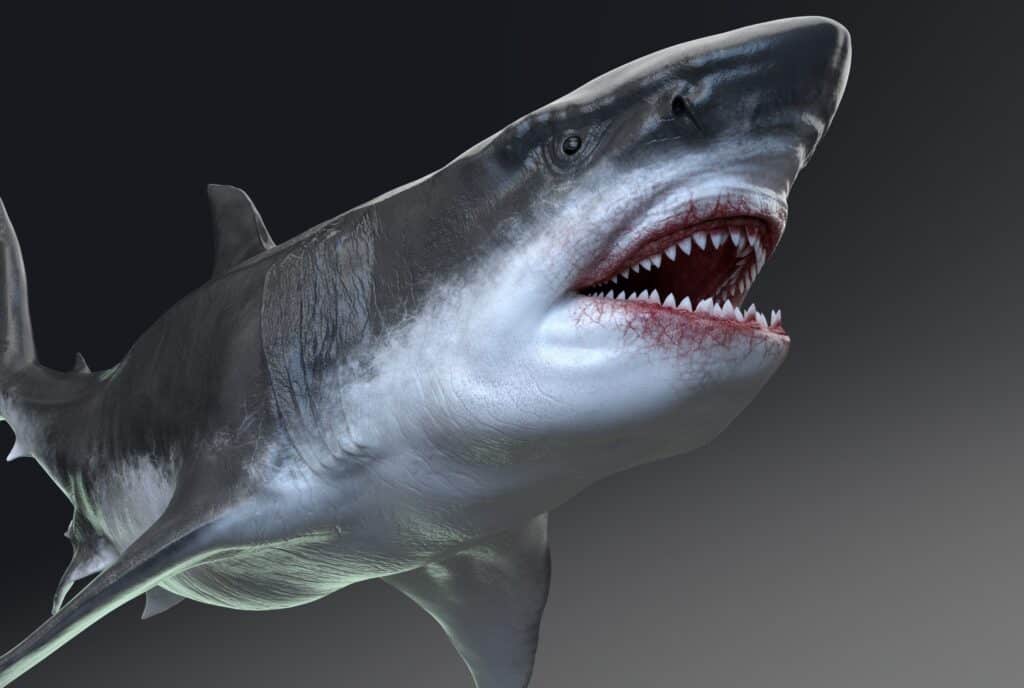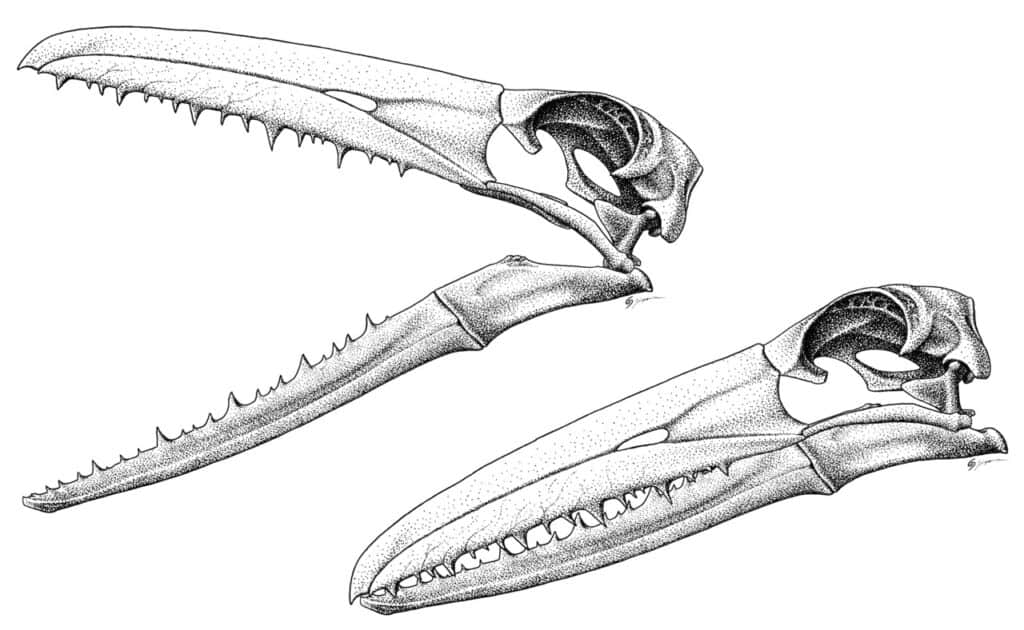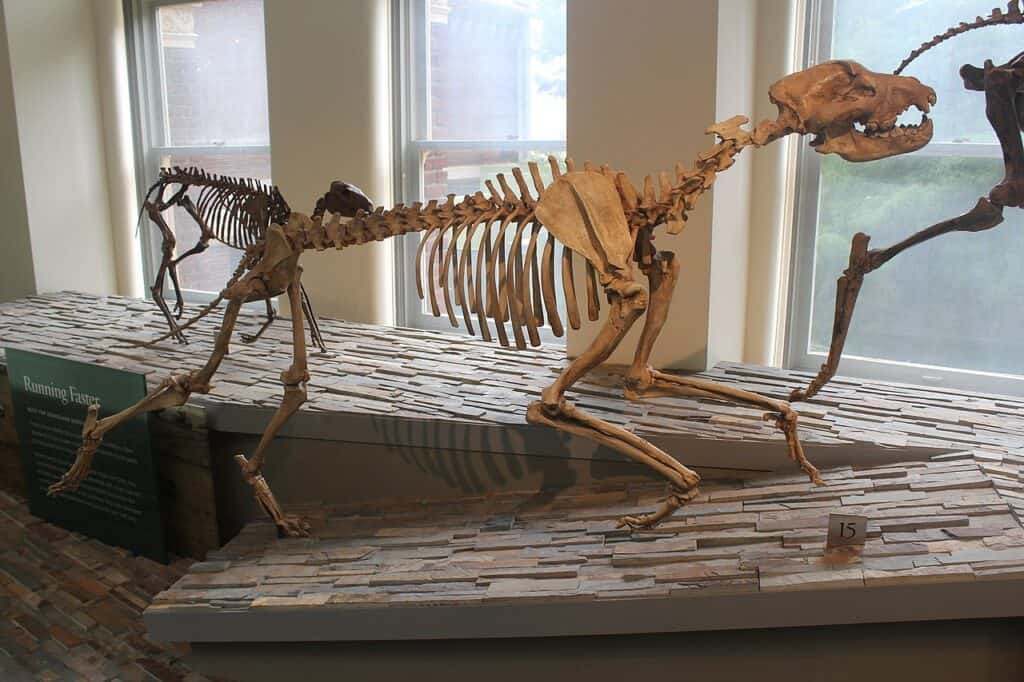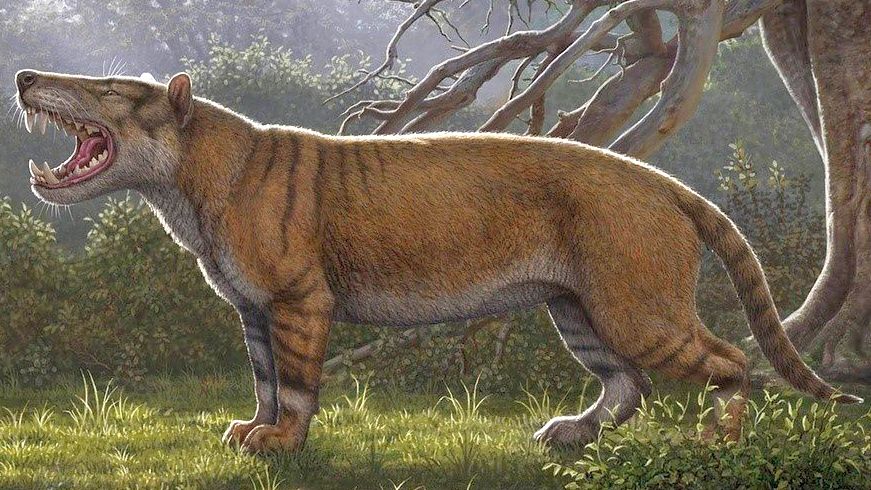The Patagotitan mayorum is believed to be the largest dinosaur species to have ever walked the earth. According to several sources, these land monsters were up to 122 feet (37.2 m) long and were almost 20 (6.1 m) feet at shoulder length. However, despite their large sizes, these reptiles vacated the earth about 65 million years ago and gave room for other massive creatures to reign. While most of these massive post-dinosaur-period creatures are now extinct, it’s interesting to consider just how large these animals were. Here are 8 of the largest animals that have lived since dinosaurs went extinct.
Titanoboa

Titanoboa weighed over 2,500 pounds and was close to 42 feet long.
©Dotted Yeti/Shutterstock.com
One of the largest animals to exist after dinosaurs went extinct was the Titanoboa. Titanoboa were large snakes believed to have existed 58-60 million years ago, just a few million years after dinosaurs went extinct. Titanboa were constrictors believed to have been 42 feet (12.8 m) long and weighed over 2,500 pounds (1134kg).
These monsters mostly fed on fish but weren’t aquatic. Instead, they lived in rainforests and also fed on birds and large reptiles, including crocodiles. Scientists were able to derive information about the species after finding pieces of its backbone and skull. They discovered about 28 different fossils in Colombia, a country in South America.
Blue Whale

Blue whales weigh up to 300,000 pounds and are about 75 to 79 feet long.
©Andrew Sutton/Shutterstock.com
The blue whale is, perhaps, the only animal on this list that still exists. These aquatic mammals grow up to 75 to 79 feet (22.9 – 24.1 m) long and weigh as much as 330,000 pounds (149,685 kg), making them larger than any animal on this list. Blue whales go way back and appeared as early as 1.5–1.25 million years ago, making them much younger than dinosaurs but a lot older than humans.
Despite their large sizes, they mostly eat krill, small crustaceans that grow between 0.4 and 1.6 inches (1 – 4.1 cm) long and weigh just about 0.04 ounces (1.1 grams). It is approximated that blue whales eat up to 8,000 pounds (3,629 kg) of krill every day. Blue whales aren’t known to attack humans in the wild, but captive blue whales have killed 4 humans since the 1970s.
Megalodon

The Megalodon weighed over 100,000 pounds and was up to 50 feet long.
©racksuz/Shutterstock.com
The Megalodon is the largest shark species to live. This massive sea monster last swam the earth’s waters about 3.6 million years ago and was introduced about 42 million years after dinosaurs went extinct. These sharks weighed over 100,000 pounds (45,359 kg) and were up to 50 feet (15.24 m) long, making them 20 to 50 times larger than great whites.
It is estimated that these sharks had a bite force of 182,201 newtons which was certainly enough to help them successfully prey on other sharks, sea turtles, and even whales. Megalodon consumed approximately 2,500 lbs of food per day.
Pelagornis Sandersi

The Pelagornis sandersi is considered the largest flying bird species and had a wingspan of about 20 to 24 ft (6.1 to 7.4 m).
©Jaime A. Headden (User:Qilong) / CC BY 3.0 – License
The Pelagornis sandersi is considered the largest flying bird species to have existed. Its fossils were found in South Carolina about 25 million years ago. Since only one specimen has been found, we cannot accurately say if it was average in height.
However, according to BBC NEWS, the fossils showed that the specimen had a 20 to 24 ft (6.1 – 7.4 m) wingspan and weighed about 48 to 88 pounds. It is believed that the bird had large wings and a small body which helped it fly. The Pelagornis sandersi spent most of its time over the ocean, and it is believed that it could fly at least 21 feet (6.4 meters) high.
Yurlunggur Camfieldensis
Yurlunggur camfieldensis is an extinct snake species whose fossils were discovered in Australia. These large snakes were constrictors that grew as long as 19.6 feet (6 meters) and were up to 11.8 inches thick. These reptiles were believed to have been burrowers that looked quite a lot like modern-day monitor lizards. Yurlunggur camfieldensis lived about 5-30 million years ago.
Megalania Prisca

The Megalania Prisca is an extinct lizard that weighed 700-4,200 pounds and was 15 to 23 feet long.
©Петр Меньшиков / CC BY-SA 4.0 – License
Speaking of lizards, the Megalania prisca is believed to be the largest species of terrestrial lizard ever known. These large monitor lizards lived about 50,000 years ago and went extinct 11,000 years ago. They are of the Varanus genus, making them related to Komodo dragons. Weight-wise, scientists estimate that they attained 700-4,200 pounds (317.5 -1,905 kg) and were as long as 15 to 23 feet (4.6 to 7.0 m). However, given their sizes, these animals were not fast and probably ran at around 6 miles per hour.
Even more uniquely, these lizards were venomous. Scientists estimate that a bite from the Megalania prisca would have stopped blood from clotting, allowing excess blood flow from the bite wound. This would ultimately lead to shock and give the Megalania the upper hand. These lizards are believed to have had stout limbs, a full mouth of serrated teeth, and a large, crested skull.
Epicyon

Epicyon was a large genus of canines estimated to have a full body length of 7.9 feet (2.4 meters) and a total body weight of 370 pounds.
©Jonathan Chen / CC BY-SA 4.0 – License
You’re probably familiar with English Mastiffs, the world’s largest dogs, but they didn’t always have this title. About 16 million years ago to about 7 million years ago, the Epicyon roamed the earth. Epicyon is a large extinct genus of canines estimated to have a full body length of about 7.9 feet (2.4 meters). Their shoulder height was about 35 inches (90cm), and they were up to 370 pounds (167.8) heavy.
They had large heads more similar to lions than wolves. These large dogs had powerful jaws and bone-crushing teeth (extra-large premolars) that helped them crush their prey to death.
Simbakubwa Kutokaafrika

The Simbakubwa Kutokaafrika could have weighed anywhere from 620 to 3,330 pounds!
©Mauricio Anton / CC BY-SA 4.0 – License
The Simbakubwa Kutokaafrika is the largest “cat” ever to exist. By “cat”, we mean “feline”, as these prehistoric creatures belonged to the Hyainailouridae paraphyletic family. They began to walk the earth about 23.03 million years ago and died out about 5.3 million years ago. The fossils were first found in the African country of Kenya and gave scientists an incredible insight into what could have been.
They estimate that the Simbakubwa kutokaafrika could have weighed anywhere from 620 to 3,330 pounds (281 -1510 kg)! This makes them even bigger than Kodiak bears. However, despite its weight, scientists believe that the Simbakubwa kutokaafrika was an adept hunter and scavenger that fed on rhinoceroses and other large early mammals.
Up Next:
Discover the Largest Venomous Snake on Every Continent in the World
Discover the Largest River Monster to Ever Exist
5 Prehistoric Snakes (One Was the Size of a School Bus!)
The photo featured at the top of this post is © Antonio Viesa/Shutterstock.com
Sources
- PNAS, Available here: https://www.pnas.org/doi/abs/10.1073/pnas.1320297111
- Taylor & Francis Online, Available here: https://www.tandfonline.com/doi/abs/10.1080/02724634.2019.1570222
Thank you for reading! Have some feedback for us? Contact the AZ Animals editorial team.






